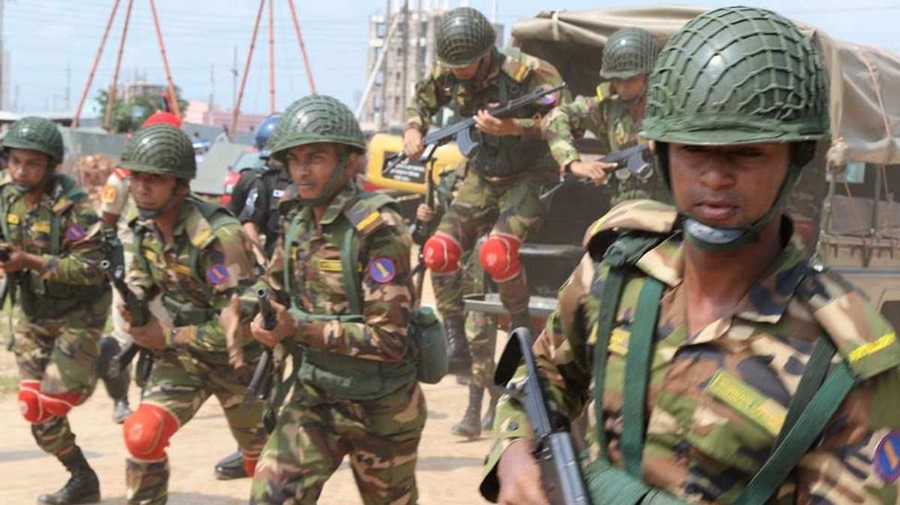Under Sheikh Hasina’s regime, forced disappearances and the torture of political opponents were notorious. Over 100 individuals remain missing to this day. Among the grim sites of detention and abuse was Aynaghar, or the ‘House of Mirrors,’ located in Dhaka Cantonment. With Hasina’s fall from power, attention has now turned to Aynaghar and the fate of its prisoners.

On August 21, 2016, Barrister Ahmad Bin Quasem Arman was arrested at his home in Mirpur, Dhaka. Two days later, former Brigadier General Abdullahil Aman Azmi was also taken into custody by law enforcement for alleged crimes against humanity during the 1971 Bangladesh Liberation War. Both men ended up in Aynaghar, also known as the House of Mirrors, a secret prison operated by the Sheikh Hasina government in Bangladesh.
Aynaghar is notorious for its brutal conditions, and those who are released from there seldom speak about their experiences.
Arman and Azmi were released on August 6, as reported by the Daily Observer. They had spent eight years in inhumane conditions without trial.
With Sheikh Hasina’s regime collapsing on August 5, attention is now focused on Aynaghar, the enigmatic detention center in Dhaka.
What is Aynaghar, the House of Mirrors in Dhaka?
The Hasina administration was infamous for its sudden disappearances and harsh treatment of political opponents. There are reportedly 23 other secret detention centers in Bangladesh, some located within Dhaka itself. Aynaghar, situated in Dhaka Cantonment, is one such facility.
Aynaghar is allegedly operated by the Directorate General of Forces Intelligence (DGFI), Bangladesh’s military intelligence agency. The facility is believed to house not only political prisoners but also extremists.
According to a 2024 Human Rights Watch report, Bangladeshi forces have been responsible for over 600 enforced disappearances since 2009, the year Sheikh Hasina came to power. While some prisoners were eventually released or presented in court, many others died in armed exchanges with security forces. The Hasina government has refused to accept UN assistance in investigating these disappearances, and allegations of torture are rarely investigated.
More than 100 people remain missing.
In 2022, BNP leader Mirza Fakhrul Islam Alamgir claimed that Tarique Rahman, son of former Prime Minister Khaleda Zia and the party’s acting chairman, was also a victim of Aynaghar. Rahman, who now resides in London, plans to return to Bangladesh.
“Those destined for murder are taken to the torture cells of Aynaghar, while those kept alive endure years of torture and confinement,” Alamgir was quoted as saying by Prothom Alo.
UN Resident Coordinator in Bangladesh, Gwyn Lewis, visited the DGFI headquarters to inquire about Aynaghar, but was told that it did not exist, as reported by The Business Standard.
How are prisoners treated in Aynaghar?
Sheikh Mohammad Salim was abducted from his auto repair shop after a phone call and found himself in Aynaghar. Hasinur Rahman, a decorated military officer, was detained there after his career ended amid allegations of militant ties. Both have shared their experiences with Netra News.
Salim described cells with no windows, high ceilings, and loud exhaust fans that drowned out other sounds. He noticed inscriptions on the walls left by previous prisoners, including pleas for their families to keep searching for them.
Salim, a victim of mistaken identity, was eventually released and went to Malaysia.
Hasinur Rahman, a former lieutenant colonel and recipient of the ‘Bir Pratik’ military award, was captured in 2018. He recognized Aynaghar from his time in the Dhaka cantonment area. Rahman was released in February 2020 and initially chose to remain silent but later spoke out about the facility’s brutal conditions.
Where is the mysterious Aynaghar located?
According to Rahman, Aynaghar has 30 soundproof cells used for torture and is guarded by both civilians and the military. During his detention, he heard others crying in various cells and felt fortunate to have been released, though many others remain imprisoned.
On August 7, the DGFI claimed there were no detainees in Aynaghar and announced plans to inspect 23 other detention centers across Bangladesh. This statement failed to convince families of the missing, who protested outside the DGFI headquarters in hopes of locating their loved ones now that the Hasina regime had fallen.
Nadira Sultana, searching for her missing husband Ataur Rahman, who disappeared in December 2011, was among those who came to Dhaka with hopes of reclaiming her family member. She started her journey at 3:00 a.m. from Madaripur, a district about three hours away from Dhaka, joined by others seeking to bring their missing relatives back home after years of torture and detention at Aynaghar.












